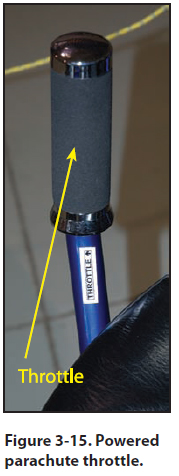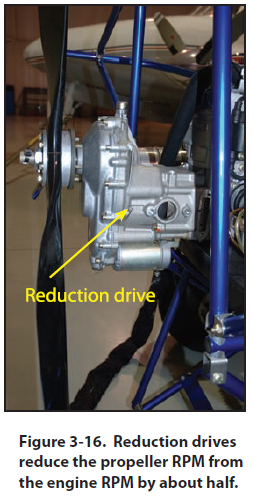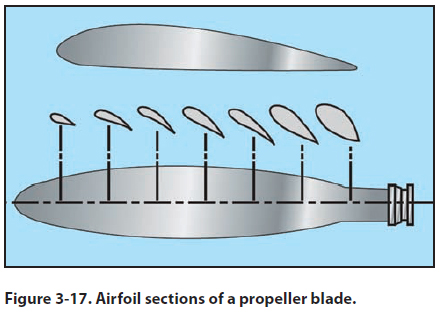|
Chapter 3 — Components and Systems
Throttle System
The throttle is the pilot’s hand control to regulate the
power provided by the engine. The configuration of
the throttle control varies from one cart manufacturer
to another. Refer to the POH of each individual PPC
for function reference. [Figure 3-15]

The Powerplant
The typical powered parachute engine can be two- or
four-stroke, liquid- or air-cooled, 50 to 100 horsepower.
Some engines have electric starters and some have
pull starters. Most PPC engines have reduction drives
that, when attached, reduce the propeller RPM to half
to one quarter the engine RPM. [Figure 3-16] The engines
are as varied as the powered parachutes they
power. Modern technology has allowed the powered
parachute engine to become lighter, more efficient
and, most importantly, dependable. Chapter 4 covers
the powerplant in more detail.

The Propeller
Propellers are “power converters” that change the
engine horsepower into “thrust.” Thrust is the force
that propels the aircraft through the air by pushing
the powered parachute forward. Aerodynamically
speaking, a propeller is a rotating airfoil and the same
principles that apply to the wing will apply to the propeller.
[Figure 3-17] Engine power is transferred to the
propeller through a rotating crankshaft that turns the
propeller through the air, producing thrust in the same
way as wings produce lift. The shape of the blade creates
thrust vectors because it is cambered like the airfoil
of a wing. Consequently, as the air flows past the
propeller, the pressure on one side is less than that on
the other. As in a wing, this produces a reaction force
in the direction of the lower pressure. In the case of
the propeller, which is mounted in a vertical plane, the area of decreased pressure is in front of the propeller,
and the force (thrust) is in a forward direction. Aerodynamically,
the thrust is the result of the propeller
shape and the angle of attack of the blade.

The typical powered parachute has a ground adjustable
propeller. The adjustment of the propeller should
only be conducted to meet the engine manufacturer’s
maximum recommended RPM target. Pilots who are
not familiar with adjusting the propeller and how it
will affect the PPC performance should consult with
a knowledgeable source prior to making any propeller
adjustments.
The engine mount is designed by individual manufacturers
for each cart configuration. The majority of
the total aircraft weight is determined by the engine
and mounting configuration. When trailering the PPC
over bumpy terrain or over long trips, the bouncing
of the cart in the trailer can put extreme stress on this
mounting system. In addition, repeated hard landings
of the cart can also stress the welds of the engine
mount. Consistent detailed inspections of the engine
mount should be an important part of every preflight
and post-flight inspection.
Just like an airplane propeller, the powered parachute
propeller turns at such great speeds that it becomes
invisible when in motion. The dangers of a turning
propeller require every pilot to maintain the highest
level of safety and respect for the consequences of
body parts, pets, and debris coming in contact with a
rotating propeller. Always treat the propeller as if the
ignition were on. Debris on the takeoff/landing field
is a danger to the propeller as well as to the people
who may be in the prop-wash area behind the propeller.
Stones, small pieces of metal, and sticks can
become dangerous projectiles if kicked into the propeller
during takeoff and landing. Just as with any
airframe or wing component of a powered parachute,
if the propeller becomes damaged, nicked or dinged,
the aircraft’s performance can be greatly affected.
Some pilots elect to use tape or rock deflector guards
to protect the leading edge from rock/debris damage.
Regardless, taking proper care of the PPC propeller is
as critical as proper engine and wing care.
|

